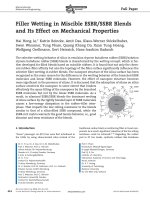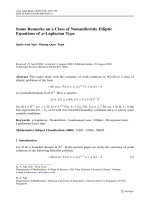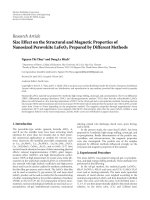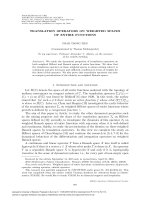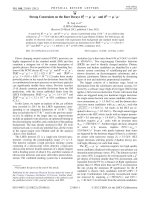DSpace at VNU: Comparative study on inhibitory activity of zerumbone and zerumbone 2,3-epoxide on NF-κB activation and NO production
Bạn đang xem bản rút gọn của tài liệu. Xem và tải ngay bản đầy đủ của tài liệu tại đây (252.83 KB, 8 trang )
Sci
Pharm
www.scipharm.at
Open Access
Research article
Comparative Study on Inhibitory Activity of
Zerumbone and Zerumbone 2,3-Epoxide on
NF-κB Activation and NO Production
Phan M. GIANG * 1, Phan T. SON 1,
Hui Z. JIN 2, Jeong H. LEE 2, Jung J. LEE 2
1
Faculty of Chemistry, College of Natural Science, Vietnam National University, Hanoi, 19 Le Thanh Tong
Str., Hanoi, Vietnam.
2
Anticancer Research Laboratory, Korea Research Institute of Bioscience and Biotechnology, Yuseong,
Daejeon 305-600, Korea.
* Corresponding author. E-mail: (P. M. Giang)
Sci Pharm. 2009; 77: 589–595
Published:
Accepted:
th
August 6 2009
August 6th 2009
doi:10.3797/scipharm.0907-16
Received:
July 23rd 2009
This article is available from: />© Giang et al.; licensee Österreichische Apotheker-Verlagsgesellschaft m. b. H., Vienna, Austria.
This is an Open Access article distributed under the terms of the Creative Commons Attribution License
( which permits unrestricted use, distribution, and reproduction
in any medium, provided the original work is properly cited.
Abstract
In the present study the significant role of the α,β-unsaturated carbonyl
structure in the anti-inflammatory activity of the natural humulane sesquiterpenoids zerumbone and zerumbone 2,3-epoxide was evidenced from a
comparative study of the ability of zerumbone and zerumbone 2,3-epoxide to
inhibit NF-κB activation and NO production in LPS (lipopolysaccharide)stimulated RAW 264.7 cells. The IC50 of these compounds were 1.97 μM ± 0.18
and 30.11 μM ± 4.10 in the NF-κB activation assay and 3.58 μM ± 0.46 and
34.7 μM ± 3.72 in the nitric oxide production assay, respectively.
Keywords
Zerumbone • Zerumbone-2,3-epoxide • NF-κB • NO production
Introduction
Nuclear factor-κB (NF-κB) consists of homodimers and heterodimers of Rel/NF-κB
proteins that bind to DNA target sites, where they directly regulate gene transcription.
Activation of NF-κB has been showed to be involved in the pathogenesis of chronic
inflammatory diseases, such as inflammatory bowel diseases and rheumatoid arthritis, and
a variety of human cancers such as leukemias, lymphomas, and solid tumors [1].
Therefore, pharmacological intervention of NF-κB could be a valuable strategy to modulate
590
P. M. Giang et al.:
inflammatory processes as well as cancer. Several small molecular natural compounds
have been reported to inhibit NF-κB at one or multiple activation steps of the signaling NFκB pathway [2–4]. The natural humulane sesquiterpenoid zerumbone (1) (Fig. 1) was
shown to modulate proinflammatory genes and cancer cell proliferation all of which are
associated with the activation of NF-κB [5–7]. Zerumbone possesses a monocyclic elevenmembered ring containing a cross-conjugated dienone moiety, which is closely resembled
to the α,β-unsaturated carbonyl group in the well-known NF-κB inhibitors such as
ent-kaurane diterpenoids [8] or sesquiterpene lactones [9]. High biological activity seems
to be dependent on the α,β-unsaturated carbonyl group of zerumbone [5] since this group
can react with the cysteine sulfhydryl groups (Cys 38 and Cys 120) in the p65 subunit of
NF-κB. Zerumbone and its natural analog zerumbone 2,3-epoxide (2) were isolated by us
from the rhizomes of the Vietnamese Curcuma zedoaria species (Zingiberaceae), which is
commercially available for the treatment of gastrointestinal disorders and ulcers [10, 11].
The significant role of the α,β-unsaturated carbonyl structure in the antiinflammatory
activity of these humulane sesquiterpenoids can be further evidenced from a comparative
study of the ability of zerumbone and zerumbone 2,3-epoxide to inhibit NF-κB activation
and NO production in LPS (lipopolysaccharide)-stimulated RAW 264.7 cells.
Results and Discussion
Zerumbone (1) and zerumbone 2,3-epoxide (2) were examined for their dose-dependent
effect on LPS (lipopolysaccharide)-induced NF-κB activation in RAW 264.7 cells, which
were stably transfected with a plasmid containing κB elements linked to SEAP (secreted
alkaline phosphatase) gene as NF-κB reporter gene. SEAP activity in the culture medium
was measured after treatment without LPS or with LPS (1 μg/mL) in the presence of
various concentrations of compounds 1 (0.3–30 μM) and 2 (1–100 μM).
13
5
O
6
10 2
9
O
4
87
3
12
11
O
1
15
14
1
Fig. 1.
2
Chemical structures of zerumbone (1) and zerumbone 2,3-epoxide (2)
As shown in Fig. 2, zerumbone potently inhibited LPS-induced SEAP activity dosedependently with an IC50 of 1.97 μM ± 0.18. Meanwhile, zerumbone 2,3-epoxide did
weakly inhibit NF-κB activity with an IC50 value of 30.11 μM ± 4.10 (Fig. 2), i.e. 15-fold
greater than that of zerumbone.
Sci Pharm. 2009; 77; 589–595.
Comparative Study on Inhibitory Activity of Zerumbone and Zerumbone 2,3-Epoxide on NF-κB … 591
Fig. 2.
Effect of zerumbone (1) and zerumbone 2,3-epoxide (2) on the activation of
NF-κB. RAW 264.7 cells transfected with a plasmid containing eight copies of
κB elements linked to SEAP gene were treated with the indicated
concentrations of 1 and 2 and then stimulated with LPS. SEAP activity in the
culture medium was measured as described in Experimental. Data represent
mean ± SD of three independent experiments performed in triplicate.
High-output production of nitric oxide (NO) produced by inducible form of nitric oxide
synthase (iNOS) is considered as a promoter of tissue injury in inflammation. Since NF-κB
is the major transcription factor involved in iNOS gene expression after exposure to
various stimuli including LPS, the effect of zerumbone and zerumbone 2,3-epoxide on the
NO production was measured in LPS-stimulated RAW 264.7 cells. RAW 264.7 cells were
treated with zerumbone (0.3–30 μM) and zerumbone 2,3-epoxide (1–100 μM) in the
culture medium, followed by stimulation with LPS (1 μg/mL). As a parameter of NO
synthesis, nitrite concentration was measured using the supernatant of RAW 264.7 cells
by the Griess reaction. Consistent with the NF-κB inhibitory activity, both compounds
inhibited nitrite production in a concentration-dependent manner with an IC50 of 3.58 μM ±
0.46 for zerumbone and 34.7 μM ± 3.72 for zerumbone 2,3-epoxide (Fig. 3). This is the
first report on the NF-κB inhibitory activity of zerumbone 2,3-epoxide. It is noticeable that in
both NF-κB activity and NO production assays almost no effect on cell viability was
observed at concentrations up to 30 μM of zerumbone and 100 μM of zerumbone
2,3-epoxide in MTT-reduction assay (data not shown).
Sci Pharm. 2009; 77; 589–595.
592
Fig. 3.
P. M. Giang et al.:
Effect of zerumbone (1) and zerumbone 2,3-epoxide (2) on nitrite accumulation
in LPS-stimulated RAW 264.7 cells. RAW 264.7 cells were treated with the
indicated concentrations of 1 and 2 and then stimulated with LPS. NO in the
culture medium was measured as described in Experimental. Data represent
mean ± SD of three independent experiments performed in triplicate.
The presence of the cross-conjugated dienone is assumed to be the structural requirement
for the inhibition of NF-κB activity of zerumbone [5] and its analog zerumbone 2,3-epoxide.
However, the inhibitory effects of zerumbone 2,3-epoxide on both NF-κB activation and
NO production were markedly weaker than those of zerumbone although the former
possesses an additional epoxide moiety, which is considered as an electrophilic site for
potential nucleophilic attack. This profound decrease in the inhibitory activity of zerumbone
2,3-epoxide on NF-κB activation and NO production may be associated with the change in
the molecular geometry of zerumbone 2,3-epoxide due to the presence of the epoxide
ring. A single-crystal X-ray analysis of the structure of zerumbone 2,3-epoxide [12]
demonstrated a conformation in which the two methyl groups at C-3 and C-7 were located
at one face of the ring while the epoxide oxygen lay on the opposite face, minimizing steric
repulsion among these groups. No effective conjugation of the double bond with the
carbonyl group can be formed since in comparison with the structure of zerumbone, the C6/C-7 double bond of zerumbone 2,3-epoxide is significantly distorted from the plane of the
dienone [12]. Therefore, C-6 of zerumbone 2,3-epoxide becomes less favorable Michael
acceptor than that of zerumbone, resulting in the weaker inhibition of NF-κB activity and
NO production.
Experimental
Phytochemicals
Zerumbone (1) and zerumbone 2,3-epoxide (2) were isolated in pure form (GC analysis
>98%) from the rhizomes of Curcuma zedoaria (Berg.) Roscoe (Zingiberaceae) growing in
Sci Pharm. 2009; 77; 589–595.
Comparative Study on Inhibitory Activity of Zerumbone and Zerumbone 2,3-Epoxide on NF-κB … 593
Vietnam as previously reported [10]. The spectral data of 1 (colorless needles, mp 67–
68° C) and 2 (colorless needles, mp 96–97° C) including IR, EIMS, 1H NMR, 13C NMR
(CDCl3) were identical with the reported values [13].
Cell lines and cell culture
RAW 264.7 cells obtained from American Type Culture Collection (ATCC, Manassas, VA,
USA) were cultured in Dubelco’s modified essential medium (Gibco/BRL, Gaithersburg,
MD, USA) supplemented with penicillin (100 units/mL) – streptomycin (100 μg/mL) –
L-glutamine (292 ng/mL) (Gibco/BRL, Gaithersburg, MD, USA) and 10% heat-inactivated
fetal bovine serum (Gibco/BRL, MD, USA). Cells were incubated at 37° C in a humidified
atmosphere containing 5% CO2. RAW 264.7 cells transfected with NF-κB reporter
construct were cultured in the same medium as RAW 264.7 cells, except for adding G418
(500 μg/mL) during maintenance.
NF-κB inhibitory activity assay
RAW 264.7 cells were transfected with a plasmid containing eight copies of κB elements
linked to SEAP (secreted alkaline phosphatase) gene. Transfected cells were seeded in a
96-well plate at a density of 5 × 104 cells/well. After 3 h incubation at 37° C, the cells were
treated with various concentrations of compounds tested and LPS (1 μg/mL) for 24 h.
Then 100 μL of each culture supernatant was transferred to a new 96-well plate and
heated at 65° C for 5 min. An additional 100 μL of 2 × SEAP assay buffer (2 M
diethanolamine, 1 mM MgCl2, 20 mM L-homoarginine) was added to each well and
incubated at 37° C for 10 min. The reaction was initiated by the addition of 20 μL of 120
mM p-nitrophenyl phosphate dissolved in 1 × SEAP assay buffer and incubated at 37° C.
The absorbance of the reaction mixture was measured at 405 nm with a microplate reader
(Molecular Devices Co., Menlo Park, CA, USA). Data represent mean ± SD of three
independent experiments performed in triplicate.
Cell viability assay
Cytotoxicity of compounds was evaluated by MTT [3-(4,5-dimethylthiazol-2-yl)2,5-diphenyltetrazolium bromide (Sigma Chemical Co., St. Louis, MO, USA)]-based
colorimetric assay. Then 10 μL of MTT solution (5 mg/μL) was added to the remaining
cells after SEAP assays. After incubation for 3 h at 37° C, the formed formazan crystals in
viable cells were solubilized with 100 μL of DMSO and the absorbance of each well was
read at 570 nm using a microplate reader (Molecular Devices Co., Menlo Park, CA, USA).
Cell numbers were obtained by standard curve.
Determination of NO production
RAW 264.7 cells were transferred in 96-well plates at a density of 1 × 105 cells/well. After
3 h incubation at 37° C, the cells were stimulated with LPS (1 μg/mL) for 24 h in the
absence or presence of the compound tested. As a parameter of NO synthesis, nitrite
concentration was measured in the supernatant of RAW 264.7 cells by the Griess reaction.
Briefly, 100 μL of cell culture supernatant was reacted with 100 μL of Griess reagent (1:1
mixture of 0.1% N-(1-naphthyl)ethylenediamine in H2O and 1% sulfanilamide in 5%
phosphoric acid) in a 96-well plate, and absorbance was read with a microplate reader at
570 nm. The nitrite concentration in the supernatants was calculated by comparison with a
Sci Pharm. 2009; 77; 589–595.
594
P. M. Giang et al.:
sodium nitrite standard curve. Data represent mean ± SD of three independent
experiments performed in triplicate.
Acknowledgements
This study was supported by the Korea Science & Engineering Foundation (Seoul, Korea),
International Foundation for Science (Stockholm, Sweden), and Vietnam National
University, Hanoi (Hanoi, Vietnam).
Authors’ Statement
Competing Interests
The authors declare no conflict of interest.
References
[1]
Yamamoto Y, Gaynor RB.
Therapeutic potential of inhibition of the NF-κB pathway in the treatment of inflammation and cancer.
J Clin Invest. 2001; 107: 135–142.
doi:10.1172/JCI11914
[2]
Zingerelli B, Sheehan M, Wong HR.
Nuclear factor-κB as a therapeutic target in critical care medicine.
Crit Care Med. 2003; 31 (Suppl. 1): 105–111.
doi:10.1097/00003246-200301001-00015
[3]
Makarov SS.
NF-κB as a therapeutic target in chronic inflammation: recent advances.
Mol Med Today. 2000; 6: 441–447.
doi:10.1016/S1357-4310(00)01814-1
[4]
Epinat JC, Gilmore TD.
Diverse agents act at multiple levels to inhibit the Rel/NF-κB signal transduction pathway.
Oncogene. 1999; 18: 6896–6909.
doi:10.1038/sj.onc.1203218
[5]
Murakami A, Takahashi D, Kinoshita T, Koshimizu K, Kim HW, Yoshihiro A, Nakamura Y, Jiwajinda S,
Terao J, Ohigashi H.
Zerumbone, a Southeast Asian ginger sesquiterpene, markedly supresses free radical generation,
proinflammatory protein production, and cancer cell proliferation accompanied by apoptosis: the α,βunsaturated carbonyl group is a prerequisite.
Carcinogenesis. 2002; 23: 795–802.
doi:10.1093/carcin/23.5.795
[6]
Takada Y, Murakami A, Aggarwal BB.
Zerumbone abolishes NF-κB and IκB kinase activation leading to suppression of antiapoptotic and
metastatic gene expression, upregulation of apoptosis, and downregulation of invasion.
Oncogene. 2005; 24: 6957–6969.
doi:10.1038/sj.onc.1208845
[7]
Murakami A, Shigemori T, Ohigashi H.
Zingiberaceous and Citrus Constituents, 1'-Acetoxychavicol acetate, zerumbone, auraptene, and
nobiletin, suppress lipopolysaccharide-induced Cyclooxygenase-2 expression in RAW264.7 murine
macrophages through different modes of action.
J Nutr. 2005; 135 (Suppl 12): 2987S–2992S.
PMid:16317159
Sci Pharm. 2009; 77; 589–595.
Comparative Study on Inhibitory Activity of Zerumbone and Zerumbone 2,3-Epoxide on NF-κB … 595
[8]
Lee JH, KooTH, Hwang BY, Lee JJ.
Kaurane diterpene, kamenbakaurin, inhibits NF-κB by directly targeting the DNA-binding activity of
p50 and blocks the expresion of antiapoptotic NF-κB target genes.
J Biol Chem. 2002; 277: 18411–18420.
doi:10.1074/jbc.M201368200
[9]
Rüngeler P, Castro V, Mora G, Gören N, Vichnewski W, Pahl HL, Merfort I, Schmidt TJ.
Inhibition of transcription factor NF-κB by sesquiterpene lactones: a proposed molecular mechanism of
action.
Bioorg Med Chem. 1999; 7: 2343–2352.
doi:10.1016/S0968-0896(99)00195-9
[10]
Phan MG, Van NH, Phan TS.
[Sesquiterpenoids from the rhizomes of Curcuma zedoaria (Berg.) Roscoe of Vietnam].
Tap Chi Hoa Hoc [J Chem (Vietnam)]. 1998; 36: 70–73.
[11]
Vo VC.
Dictionary of Vietnamese Medicinal Plants.
Ho Chi Minh city: Medicine, 1997: p. 741.
[12]
Kitayama T, Yamamoto K, Utsumi R, Takatani M, Hili RK, Kawai Y, Sawada S, Okamoto T.
Chemistry of zerumbone. 2. Regulation of ring bond cleavage and unique antibacterial activities of
zerumbone derivatives.
Biosci Biotechnol Biochem. 2001; 65: 2193–2199.
doi:10.1271/bbb.65.2193
[13]
Matthes HWD, Luu B, Ourisson G.
Cytotoxic components of Zingiber zerumbet, Curcuma zedoaria and C. domestica.
Phytochemistry. 1980; 19: 2643–2650.
doi:10.1016/S0031-9422(00)83937-0
Sci Pharm. 2009; 77; 589–595.
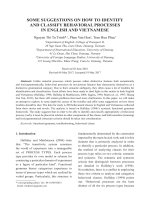
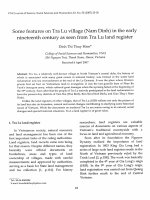
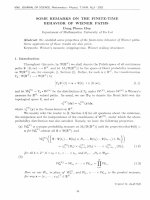
![DSpace at VNU: Corrigendum to ‘‘Nonlinear dynamic response of imperfect eccentrically stiffened FGM double curved shallow shells on elastic foundation’’ [Compos. Struct. 99 (2013) 88–96]](https://media.store123doc.com/images/document/2017_12/14/medium_vrh1513028470.jpg)

